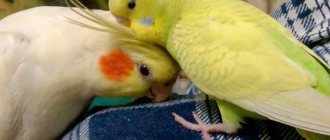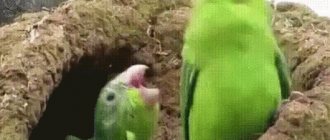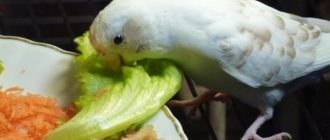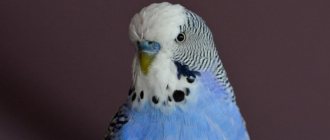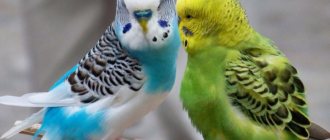Many bird lovers often wonder how different species interact with each other, and also make comparative characteristics before purchasing. Many people want to understand for themselves who is best for them as a pet.
After all, they all require different conditions for care and maintenance, but in addition they have different behavioral and character traits. Let's take a closer look.
Friendship or war between a budgie and a lovebird?
Recently, more and more often, parrot owners are trying to have not one, but two birds, or even three, at home, and more often they belong to different species.
Do you think lovebirds are friends with budgies and other parrots? Perhaps you will decide that yes, they are friends. But what do we actually get? When getting a lovebird, you must remember that this is a very aggressive bird in relation to other birds. Even if the other bird is larger and more powerful than the lovebird, it can still be harmed by it. The fact is that despite their small size, lovebirds have a very powerful and strong beak, and large birds simply may not be ready for the aggression shown towards them.
As you already know, we are breeders of tame lovebird chicks and show the utmost attention to our birds so that they grow into good, independent parrots with minimal aggression. And of course, there is always a risk that the lovebird will begin to show aggression towards the wavy.
This week we learned that our youngest, most harmless little one, beat the budgie he kept to death. Although at first everything seemed very good, the birds communicated with each other and could not live without each other. However, this is explained by the fact that at a young age, when the lovebird chick still needs care, it does not show so much aggression. A little older, the whole essence is revealed in all its glory, and its owners need to remember this. Therefore, these species should only be allowed to communicate under strict supervision.
The cause of death of an innocent bird largely relates to the negligence of the owner, and a complete lack of understanding of the responsibility for the life of the pet, its natural essence.
Therefore, we would like to once again remind all owners of lovebirds that keeping them in the same cage with other species (even if there are more of them, for example, cockatiels) is strictly prohibited! You are responsible for the lives of those you take into your home, and let's try to prevent the victims of small feathered creatures!
I would like to note that when discussing this topic on the forum, many owners of both types began to try to convince me:
“Yes, they’ve been friends with me all my life!”
“Yes, I better know how they communicate!”
“There have never been any problems and there never will be!”
Alas, none of these phrases will protect your birds from aggression. The same can be said about other animals, such as cats. The cat may not touch the bird until its hunting instincts kick in. Similarly, in lovebirds, aggression may appear a little later.
Source
Vivid examples
For example, let’s take a situation where a neighbor of the opposite sex was placed with a lonely lovebird. Before creating a couple once and for all, these parrots choose a partner for a long time and meticulously. If the birds cannot get along, they will constantly sort things out: fight, peck each other. Females are especially aggressive - they can peck unattractive males to death. What can we say about other birds?
Only one conclusion suggests itself - it is strictly prohibited to place other species of birds in the cage of lovebirds.
From a small and modest siskin, twelve centimeters long, there will not be a “wet spot” left. Budgerigars, with their twenty centimeters, also cannot stand being in the vicinity of an aggressor. Large parrots, African Grays, cockatoos or Amazons will most likely fight off the attack of one lovebird. They might not be able to handle two, let alone a whole flock.
Which is better - a lovebird, a budgie or a cockatiel?
In this article, I would like to look at the so-called pros and cons of these three most popular pet parrots: lovebird, budgerigar and cockatiel. However, I will not use specific familiar templates, but will share my experience of maintaining all three types. In general, the popularity of all three parrots is easily explained, because if you came across this article, then you yourself understand: these birds do not require much space, they are unpretentious in keeping, do not require large expenses for food, will not be able to injure you, and most importantly, everyone can afford such a pet - even with the most modest budget.
When desire is stronger than circumstances
What should you do if you want to get lovebirds, but you already have other birds or vice versa? There is a solution - keeping these parrots in a separate cage. Moreover, it cannot be placed close to cages with other birds. Otherwise, aggressive birds will be able to reach out and injure potential rivals.
Birds can only be released from their cages under constant supervision. Lovebirds often bite other birds on the feet, which can cause bleeding and death. By turning away even for a minute, the owner risks losing one of his pets. Even if the lovebird makes friends with someone, you should not lose sight of them.
If you have tried keeping different birds together, please share your observations in the comments.
If you liked the article, please like it and share it with your friends.
Source
So the main typical advantages of all three birds are:
However, there are also disadvantages that I would like to highlight separately, and which I also have to deal with every day, or rarely:
But all the disadvantages are of course outweighed by the advantages. At the moment I have 5 lovebirds (parents and chicks) and one budgie. Now I’ll tell you more about the experience of keeping all birds.
In terms of beauty, I would say that everyone has their own preferences, but the wavy looks the least exotic, unlike the cockatiel, which is approximately similar to a small cockatoo, and will differ quite well in weight on the hand. The lovebird is an average bird, and has more wavy birds, although not significantly. They all eat about the same, they litter - it all depends on the bird. If you happen to be a slob by nature, then nothing can save you. Another plus for the wavy and cockatiel is the ability to imitate human speech well, unlike the lovebird.
Experience with wavy. I've always had budgies. I want to say that it all depends on the bird and its character. So the first bird was super tame and no other animals were needed, since the bird replaced both a cat and a dog: the bird was 100% tame, spoke worse than a cockatiel, and was with its owner everywhere. Yes, you can only dream about this. He sang and talked a lot. He was really sloppy, there was plenty of garbage. Wavys have the most pleasant voice and chirping. It was also very easy to train him: his cage was always open and eventually the bird made contact on its own. The wavy “girl,” on the contrary, turned out to be very aggressive and never got used to humans in her life, although she was kept with a boy. We took the current parrot as a boy, since experience has shown that they are much better. But this is everyone's business. The deaths were due to carelessness: one was eaten by a cat, the second flew away at the dacha, the third contracted the infection from the street. Budgerigars are the cheapest.
Experience with lovebirds. I had no intention of getting lovebirds at all, but as fate would have it, we caught a bird on the street. A very good bird, but the voice is very specific and screams more than sings, this is a huge minus. And then it turned out that they were not talking yet. It turned out to be not difficult to treat (for scabies) the bird; it is not picky about its diet. Taming - the same, a constantly open cage, the bird quickly made contact and became tame. After acquiring the boy, she went wild, like all birds living in pairs. After the chicks appeared, both became very aggressive. But the chicks are just sweethearts (but I think this applies to all chicks), without being separated from their parents, but with constant contact they turned out to be tame very easily. In my opinion, lovebirds are very, very beautiful and cool, they are very inquisitive and active (I would say more active even than that super wavy one that we had), and you can feel it more strongly by the weight on your hand. There was not a single death, but the cat could not fight back. The birds are smart but impudent, they understand everything and do it to spite their owner. Unlike wavy and cockatiels, it has the strongest beak, which can bite quite hard. It is strictly forbidden to keep it with other birds. Average price category.
How to choose
How to determine who will make the best pet - a cockatiel or a lovebird? This can be resolved by answering the following questions:
How much time will be devoted to the pet? Is it possible to have two animals if you don’t have a lot of free time? Will noise from your pet be tolerated calmly? Is it important for a bird to be able to talk?
If you don’t have much time for a pet, and your budget or free space in the house doesn’t allow you to have a pair, it’s better to choose a cockatiel. They tolerate loneliness more calmly.
But at the same time, cockatiels make more noise than lovebirds. Moreover, these sounds cannot be called pleasant or melodic. In addition, the acquired pet may be particularly noisy or demanding.
Only lovebirds can talk. He remembers few words, and only if he starts learning as early as possible and acts diligently and consistently.
If, after answering all the questions, the choice is still not made, all that remains is to focus only on the appearance of the birds. Cockatiels look exotic, but lovebirds have variegated colors.
cockatiels
Cockatiels are small parrots.
Their size is the same as that of pigeons. The body length is 29-34 cm. The tail is quite large, it is 1/2 the size of the bird. A distinctive feature of these parrots is the prominent feathers on their heads in the form of a crest. Males have gray feathers and a yellow crest. The wings are black or dark blue. The cheeks are always orange. Females are lighter in color. The advantages of this breed are that the birds are usually friendly and get along easily with other birds. Many will also like the fact that the birds can talk and even try to sing, imitating the singers. However, potential owners need to think about whether they are ready to listen to these songs regardless of their desire.
Birds are very smart and quick-witted. But they require a lot of attention, as they become very attached to their owner. But, thanks to their extraordinary sociability, they will always be true friends. In this they have no equal.
For a cockatiel, you need to purchase an aviary or a spacious cage, but in no case a wooden one, since these birds have a very strong beak, and the cage can quickly deteriorate. It is best to place the cage where the owner is most often, so that the birds do not get bored. A small bath and toys can also make your parrot happy. It is necessary to release these birds from their cages every day.
The disadvantages include the fact that cockatiels can open locks in the absence of their owners, and this can be dangerous, first of all, for them. Therefore, the owner must ensure that the cage closes securely. If these birds are unhappy with something, they will not remain silent, but will express their emotions with unpleasant sounds. Sometimes they are capricious and vindictive.
The other side of the coin
Harmless at first glance, lovebirds have such dangerous character traits as:
Together with a very strong and sharp beak, capable of causing a deep wound, these parrots become serious opponents even for large birds. Especially if they think that someone has decided to encroach on their territory, partner or food.
In nature, flocks of wild lovebirds constantly fight among themselves for possession of territory. Members of the same flock can even fight off their brother if he falls into the claws of a bird of prey.
Domesticated parrots have not lost their natural skills - the desire to fight for personal space and property is in their blood.
Budgerigars
Budgerigars are clearly superior to other birds in their speaking abilities.
They are very fun to be with, they don’t need to be taught to speak for a long time, because they themselves try to repeat even those words that they were not specifically taught. These birds will definitely not let you get bored. Birds are very sociable. You can even conduct a kind of dialogue with them; they carry on the conversation in their own way. Caring for parrots involves cleaning the cage every day, changing the water and replenishing the feeder. Once or twice a day, you can give your pet an apple, as well as an orange or tangerine, as they contain vitamin C, which is especially needed during molting and in winter. It is best to start growing oats, millet or wheat, as they contain useful substances necessary for budgies. You can treat your bird to egg whites no more than once a week. Occasionally you can give the birds soaked bread or crackers. As you can see, the diet of birds of this breed requires special attention.
As for color, green and blue colors predominate in the plumage of budgerigars. There are also purple and blue shades. The colors are both regular and especially variegated. Green and blue parrots have a kind of “mask” of yellow or white color on their muzzle. The wings, head and back are decorated with a wavy pattern. Variegated colors also most often come in green and blue tones. But against the background of these flowers there are yellow or white spots. The size of these birds is about 18 cm.
Without a doubt, the birds are beautiful and friendly, but if potential owners are wondering whether they are lovebirds or budgies, it is still recommended to choose lovebirds.
Fasting is prohibited
Lovebirds have an increased metabolism: energy is needed for flight, and food is needed for energy. Therefore, these parrots have a body temperature exceeding 40 °C, and the stomach continuously produces gastric juice and digests incoming food in a matter of hours
Lovebirds cannot go hungry; it is important to provide your pet with constant access to food: he will not eat too much, and a lack of food will cause negative consequences
This does not mean that you can feed lovebirds the same thing, just to ensure a feeling of satiety. A meager diet will lead to a deficiency of minerals, and the parrot will simply get bored.
https://youtube.com/watch?v=iFtfivRVgr0
Lovebirds
Many may be frightened by the thought that lovebirds live only in pairs, and if one of the parrots suddenly dies, the other will not survive this loss. However, this is just an exaggeration and a beautiful fairy tale. There is only a grain of truth in this. Indeed, lovebirds become very attached to their significant other. They do literally everything together - eat, have fun, clean their feathers. Naturally, lovebirds take their loss seriously. During this period they need a lot of attention. If a “widowed” lovebird did die, it was usually due to the fault of the owners, and the reason for this was improper care. With proper care, a lovebird will eventually be able to survive the loss and even find a soul mate again.
Contract of sale?
In some more developed Western countries, the sales process looks like this: first the seller takes an analysis, then if the bird is healthy, it is bought, a sales contract is drawn up, then the buyer takes the same tests - and if there is a discrepancy, the contract is considered invalid and the seller pays all expenses.
Try approaching one of our breeders with this approach, and even about a cockatiel. They will send you. Try going to a pet store with this approach. They will send you. They didn’t even know about any tests or diseases, with a high probability they will learn about all this directly from you, it’s true - if you read this article to the end, then you already know more than an ordinary pet store salesperson about selling and buying cockatiels. Cool, yeah?
Many breeders chant the phrase “live goods cannot be exchanged or returned” + refer to the veterinary regulations that the bird must be healthy for the already mentioned psittacosis, bird flu and salmonellosis with helminths (in fact, this increasingly concerns the mass sale of chickens to poultry farms, our Veterinary medicine is mainly geared towards this).
But this is theoretically not so - in the law on the protection of consumer rights there is also a clause about a product of inadequate quality, and if something is opened later, some kind of virus is found - then the bird can seemingly be returned, i.e. return the money. In practice, as far as we personally watched the trials, this is difficult to the point of impossible. And you definitely won’t be able to do this with a cockatiel.
And not only with cockatiels. So in practice there is no point in requiring a purchase and sale agreement. As one of our familiar breeders said, she does it purely for the sake of respectability, so that she can take a couple more thousand rubles from above.
What is the best parrot to get?
There are more than 350 species of parrots in nature. Most of them live only in nature. Domestic parrots differ from their wild counterparts in their calmer disposition. Among the variety of all breeds, it can be quite difficult to decide which parrot is best to get. Each species has its own characteristics and abilities, and also differs in character and behavior.
Which parrot is better to get:
Parrots are often kept for children so that they learn care and responsibility. In this case, it is not recommended to choose large species of parrots, since they are demanding in terms of care and maintenance.
Even experienced owners do not keep some types of large parrots, since it is quite difficult and expensive to provide them with comfortable living conditions. Before deciding which parrot is worth purchasing, you need to take into account your financial capabilities and evaluate the conditions for keeping the parrot.
To keep a parrot you will need:
It is very important to choose a young and healthy individual. If a parrot sits silently in a cage and does not pay attention to others, it may be sick. You should also be wary of a parrot that sits ruffled.
It is worth paying attention to the appearance of the parrot. The plumage should be even and smooth, there should be no ruffled feathers. There should be no peeling or growths on the beak and paws. The eyes should be bright and the cloaca clean.
Let's look at the most popular types of parrots to keep at home.
Release
Birds are born to fly. A pet parrot, confined to a cage, also wants to feel free. When the main stages of taming the cockatiel have been completed, you can allow it to go for walks. Before opening the door, the space needs to be secured as much as possible:
- remove animals;
- take out the plants;
- hide small items;
- close windows and doors.
Having prepared the room, they open the cage and try to lure the parrot out. One way is to bring your hand to the bird, and when it sits down, slowly pull it out. If the cockatiel is showing anxiety, do not rush it. You need to encourage your pet, and it will begin to flutter freely.
Taming a cockatiel is interesting and educational. Communicating with a smart bird, a person himself changes and discovers new abilities. Coercion and punishment are not the measures that should be used. Raising a bird requires love and patience.
Budgerigar
An excellent option for children and for those who first decided to have a parrot in the apartment. This is the most popular and common type of parrot for home keeping. The budgerigar is unpretentious and does not require care and maintenance. To keep one individual you will need a cage 40 by 60 cm.
They are small in size from 12 to 18 cm, live 10-15 years. Prices for such a parrot start from 500 rubles.
Budgerigars are very cheerful, playful and sociable birds. They bite extremely rarely and do not hurt; they are easy to tame. A budgerigar can also be taught to talk.
How to choose
How to determine who will make the best pet - a cockatiel or a lovebird? This can be resolved by answering the following questions:
How much time will be devoted to the pet? Is it possible to have two animals if you don’t have a lot of free time? Will noise from your pet be tolerated calmly? Is it important for a bird to be able to talk?
If you don’t have much time for a pet, and your budget or free space in the house doesn’t allow you to have a pair, it’s better to choose a cockatiel. They tolerate loneliness more calmly.
But at the same time, cockatiels make more noise than lovebirds. Moreover, these sounds cannot be called pleasant or melodic. In addition, the acquired pet may be particularly noisy or demanding.
Only lovebirds can talk. He remembers few words, and only if he starts learning as early as possible and acts diligently and consistently.
If, after answering all the questions, the choice is still not made, all that remains is to focus only on the appearance of the birds. Cockatiels look exotic, but lovebirds have variegated colors.
Lovebirds
Suitable for busy people who have little free time. It is best to have a couple of lovebirds, then they will be busy with each other all the time. In the absence of a mate, the lovebird requires attention and becomes very attached to the owner.
It is not recommended to keep parrots in the same cage with other species. They can behave aggressively towards another species and cause damage.
The size of the lovebird is 10-17 cm, lives 10-15 years. Prices for one individual start from 1,000 rubles.
Character traits
Small bright lovebirds are very funny birds. The couple is almost always busy with each other, because it’s not for nothing that these parrots were named that way. You can spend hours watching the birds coo while sitting side by side. The male touchingly cares for the female, the female preens in front of the male.
A lovebird kept alone is also good - curious, active, and sincerely happy with its owner. If a lonely parrot is tamed, then during walks around the room it will not leave its owner, asking to play with him.
It would seem that such parrots will be able to get along with other birds. Together they will live amicably and cheerfully. But it's not that simple.
Ruffled parrot
A very intelligent and friendly type of parrot. Males have a dark necklace-like stripe around their necks. Because of this feature, this species got its name. Females do not have such a stripe.
The size of the parrot is 35-45 cm, they live 20-30 years. Price from 15,000 rubles.
A large cage or enclosure is required for maintenance. Easy to tame and highly trainable. They train well and can be taught to talk. Of the minuses, it should be noted that this parrot makes loud sounds that are unpleasant for many.
The African Gray Parrot is suitable for experienced bird keepers. Very smart and artistic birds. They are able to imitate human speech and funny imitate pets.
Size 30-35 cm, live 40-60 years. Prices for grays start from 60,000 rubles.
The purchase of this type should be taken seriously. They require a lot of attention. Grays need to be handled and trained, otherwise they can become aggressive and daring. When choosing an African gray parrot, you should pay attention to its behavior. He must be tame and must not show aggression.
These are quite large and expensive parrots. A separate room is required for maintenance. Before getting such a parrot, it is necessary to study all the behavioral features and rules for keeping such a bird.
The size of the parrot is 60-70 cm, they live 50-60 years. Prices start from 50,000 rubles.
This is a beautiful large parrot with bright multi-colored plumage. They have high intelligence and have monogamous vision. Very touchy. They make loud screaming sounds.
Optimal age to buy
Young birds are more active than adults and are easier to train. Here are some tips for choosing the right young parrots:
- purchase birds only in trusted places, that is, in pet stores or from trusted breeders;
- it is advisable that the age of the bird at the time of purchase does not exceed four months (you will obtain this information from your sales consultant or breeder);
- You should not take birds under four weeks of age, because... they may not yet be completely independent;
- parrots brought from the wild are noisier and louder than birds raised in captivity.
Is it worth getting a parrot?
Before getting a parrot, you need to carefully weigh the pros and cons of whether it is worth getting a parrot. You should also evaluate your capabilities. Both time and financial costs will be required.
Among the advantages of keeping small parrots, it can be noted that they take up little space, you do not need to walk with them every day, you can leave the parrot unattended for a couple of days. Large species of parrots are a source of pride for the owner. Experienced breeders try to acquire the rarest species with bright, unusual plumage.
If you have no experience communicating with birds, it is worth getting a small parrot that does not require special care and special conditions. Often, in pursuit of fashion, people try to immediately purchase a large and expensive parrot. But without the knowledge and skills to keep such parrots, the birds often suffer from unsuitable living conditions and often get sick, which leads to premature death.
Difficulties in maintenance
The birds are allowed to roam daily and defecate anywhere. Small parrots cannot be litter trained. Pets are also very curious and will regularly “taste” different objects: chew furniture, wires, books, indoor plants. It is advisable not to leave them outside the cage unattended.
Many lovebirds are aggressive towards parrots of other species. The rosy-cheeked ones are especially pugnacious. These birds can attack even larger relatives, causing them serious injuries, sometimes incompatible with life. They are not aggressive with individuals of their own species and coexist quite peacefully.
Range, habitats
The natural habitat of these parrots is southern Africa (tropical forest zones). They are social birds and live in flocks, or colonies. Choose places near bodies of water - lakes or rivers.
Different species have their own habitats:
- red-faced: Sierra Leone, Tanzania, o. Sao Tome;
- rosy-cheeked: South Africa, Angola, Namibia;
- grey-headed: o. Madagascar, Seychelles, Zanzibar;
- black-cheeked: Zambia.
But it is possible for representatives of several species to live in the same territory. The average lifespan of birds is 10 years. If an individual is in good health and living conditions are above average, it will live up to 15 years.
